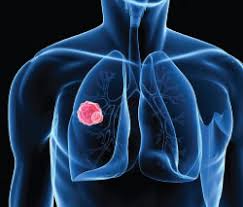
Diagnosed with Cancer? Your two greatest challenges are understanding cancer and understanding possible side effects from chemo and radiation. Knowledge is Power!
Learn about conventional, complementary, and integrative therapies.
Dealing with treatment side effects? Learn about evidence-based therapies to alleviate your symptoms.
Click the orange button to the right to learn more.
Upfront Low-dose Radiation SCLC

According to the study linked below, upfront low-dose radiation for small cell lung cancer extends both progression-free survival (your first remission) and overall survival (length of life). That’s great news…
Until you dig into the specifics a little deeper. Small cell lung cancer (SCLC) is a difficult cancer with a short average survival. I am a long-term cancer survivor (different type of cancer) who struggles with long-term and late stage side effects. Many of which are radiation-induced.
You don’t want to live the remaining time after your diagnosis struggling with radiation-induced side effects. Which are common according to the research below.
The therapies shown to reduce or even heal damage from radiation therapy are:
- Pre-Habilitation-
- Melatonin, Resveratrol-
- Hyperbaric Oxygen Therapy (HBOT)
- Low dose therapies aka less toxicity means less damage-
Pros:
- Improved Local Control: Low-dose radiation can effectively target the tumor site, leading to better control of the disease in the lung.
- Symptom Relief: Radiation therapy can alleviate symptoms associated with SCLC, such as pain, coughing, and difficulty breathing, improving the patient’s quality of life.
- Tumor Shrinkage: Even low doses of radiation can cause tumor shrinkage, which may facilitate subsequent treatments like chemotherapy or surgery.
- Palliative Care: In cases where the cancer is advanced and not curable, low-dose radiation can be used for palliative care to relieve symptoms and improve comfort.
Cons:
- Potential Side Effects: Radiation therapy can cause side effects, including fatigue, skin irritation, difficulty swallowing, and lung inflammation. These effects may be more pronounced with higher doses but can still occur with low-dose radiation.
- Risk of Radiation Toxicity: Though less likely with low doses, radiation therapy carries the risk of damaging healthy tissues surrounding the tumor, leading to long-term complications.
- Limited Efficacy: Low-dose radiation alone may not be sufficient to eliminate the cancer completely, especially in more advanced cases. It’s often used in conjunction with other treatments like chemotherapy.
- Risk of Cancer Recurrence: There’s a possibility that cancer could recur after low-dose radiation therapy, particularly if it’s not followed by additional treatments or if the cancer has already spread beyond the lungs.
You’ve been diagnosed with an especially difficult cancer- small cell lung cancer. My experience and research indicates that you should include both conventional and evidence-based non-conventional therapies in your therapy plan in order to give yourself every possible therapy advantage.
If you’d like to learn more about lung cancer therapies, let me know at David.PeopleBeatingCancer@gmail.com
Hang in there,
David Emerson
- Cancer Survivor
- Cancer Coach
- Director PeopleBeatingCancer
Upfront Low-Dose Radiation Improves Advanced SCLC Outcomes
“Adding low-dose radiation to the current standard first-line treatment, durvalumab plus etoposide-platinum chemotherapy, appears to improve survival outcomes in patients with extensive-stage small cell lung cancer (SCLC)..
The standard first-line treatment results came from the 2019 CASPIAN trial, which found that patients receiving the first-line regimen had a median progression-free survival of 5 months and a median overall survival of 13 months, with 54% of patient alive at 1 year.
The latest data, which included a small cohort of 30 patients, revealed that adding low-dose radiation to the standard first-line therapy led to a higher median progression-free survival of 8.3 months and extended median overall survival beyond the study follow-up period of 17.3 months. Overall, 66% of patients were alive at 1 year…
In the current single-arm study, Zhang and his team added 15 Gy radiation in five fractions to the primary lung tumors of 30 patients during the first cycle of durvalumab plus etoposide-platinum…
Grade 3 treatment-related adverse events occurred in 80% of patients, most frequently hematologic toxicities. Five patients (16.7%) had severe adverse reactions to radiation. Although the overall dose of radiation was low, at 3 Gy each, the fractions were on the large side…
Efficacy of ω-3 Polyunsaturated Fatty Acids in Patients with Lung Cancer Undergoing Radiotherapy and Chemotherapy: A Meta-Analysis
“Results- A total of 7 studies were included. The SMDs (95% CI) of body weight change, albumin change, energy intake, and protein intake at the end of intervention were 1.15 (0.50, 1.80), 0.60 (0.11, 1.09), 0.39 (−0.10, 0.89), and 0.27 (−0.04, 0.58), respectively. The SMDs (95% CI) of CRP change and TNF-α change were −3.44 (−6.15, −0.73) and −1.63 (−2.53, −0.73), respectively.
Conclusions- ω-3 PUFAs can improve nutritional status and regulate indicators of inflammation in patients with lung cancer undergoing radiotherapy and chemotherapy. This study was registered in the PROSPERO (registration number: CRD42022307699).”
Curcumin Blocks Small Cell Lung Cancer Cells Migration, Invasion, Angiogenesis, Cell Cycle and Neoplasia through Janus Kinase-STAT3 Signalling Pathway
“In this study, we found that curcumin can inhibit SCLC cell proliferation, cell cycle, migration, invasion and angiogenesis through suppression of the STAT3. SCLC cells were treated with curcumin (15 µmol/L) and the results showed that curcumin was effective in inhibiting STAT3 phosphorylation to downregulate of an array of STAT3 downstream targets ,which contributed to suppression of cell proliferation, loss of colony formation, depression of cell migration and invasion…”

